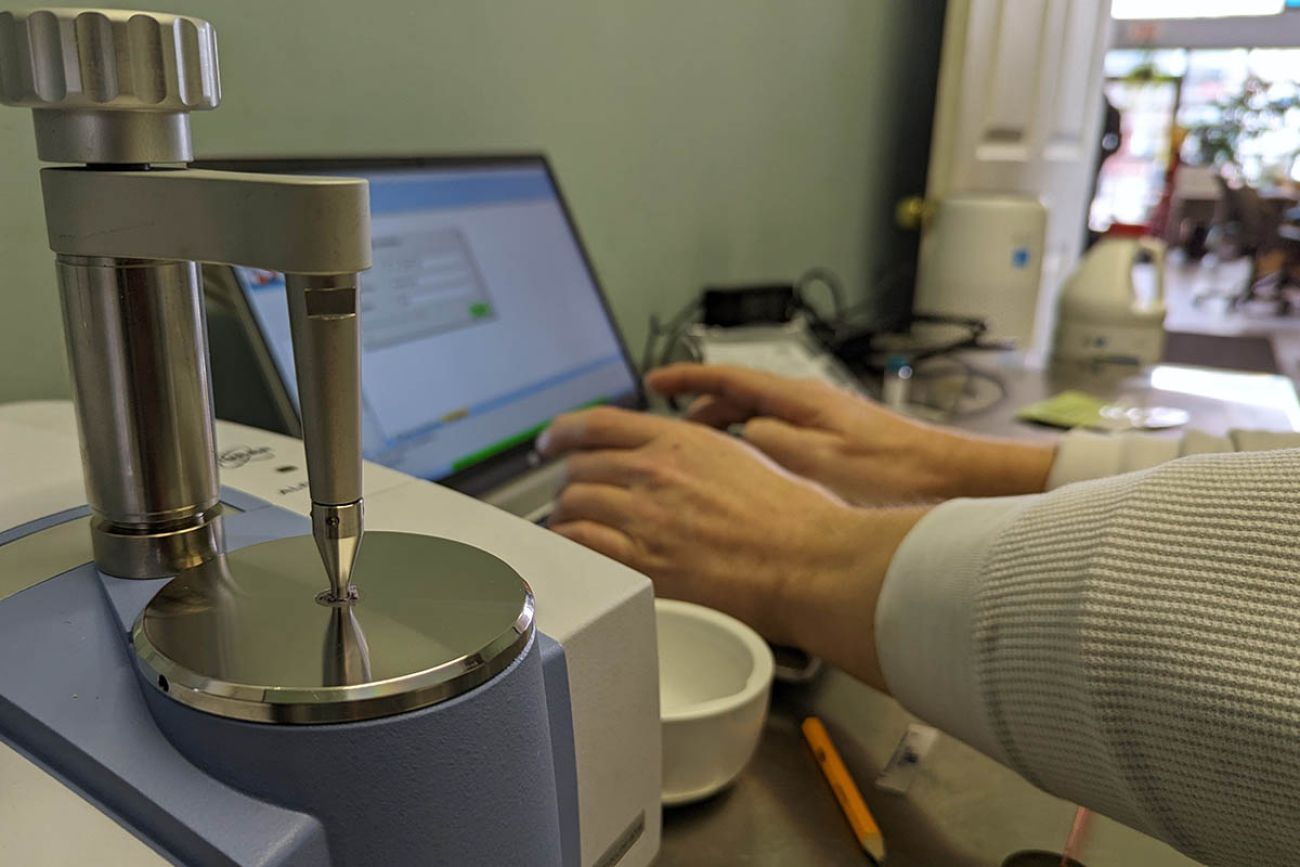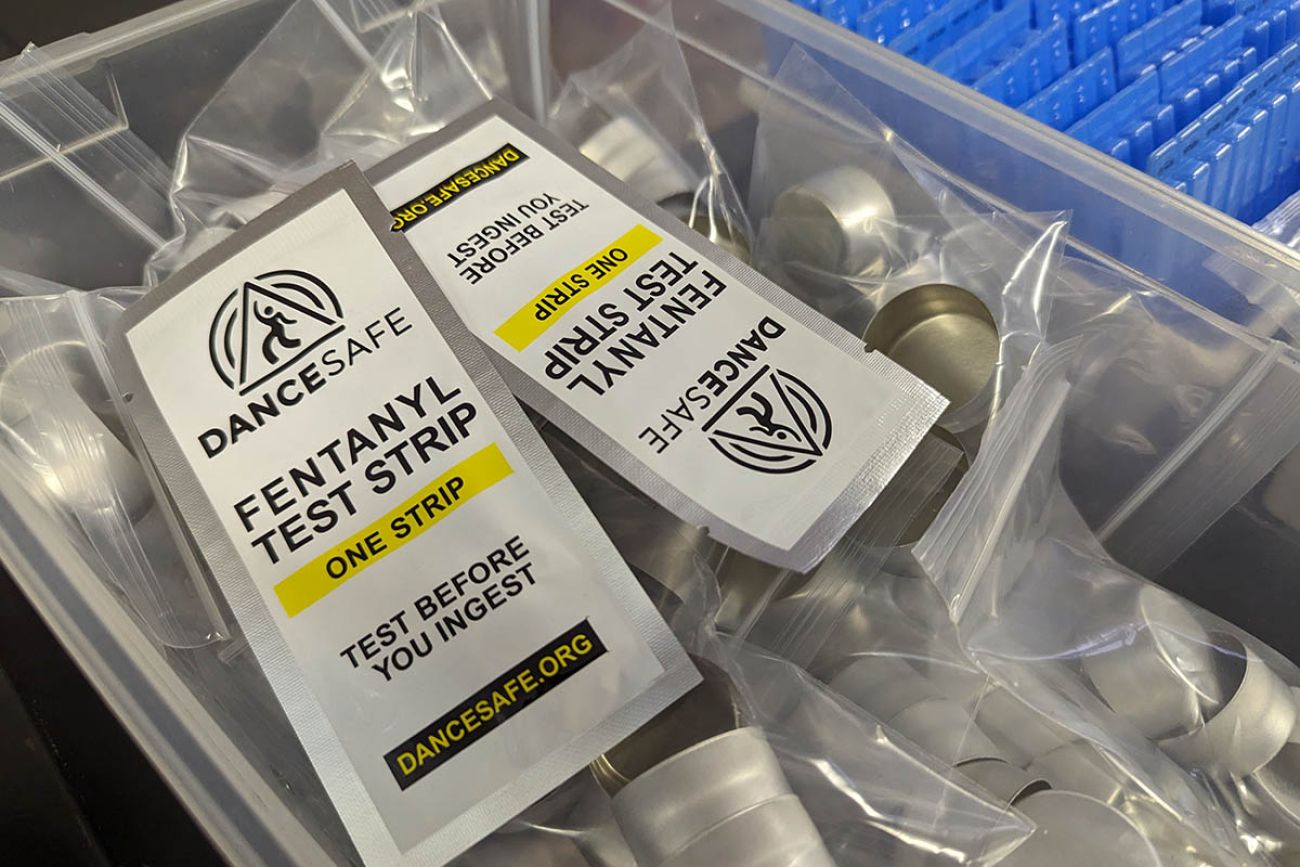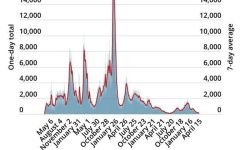Fighting Michigan's opioid crisis with new needles, purer drugs, respect for addicts


- One strategy in Michigan’s fight against opioids is ‘harm reduction’ — the acknowledgement that just-say-no doesn’t always work
- In Grand Rapids, one harm reduction program tests drugs, alerting the user of what’s in the sample
- The program, Red Project, has found xylazine, also known as ‘tranq,’ and deadly additives in the local supply
GRAND RAPIDS — The peak in the squiggly blue line is undeniable: There’s a large-animal sedative — xylazine, or “tranq” — in these tiny light purple clumps of powder that someone might shoot into his veins, smoke or snort.
Whether the owner will use these street drugs with the potentially deadly xylazine on board is unknown, said Nick DeHaan, coordinator of the state’s first public drug-checking service, at least of this scale.
“It's totally up to each individual,” he said.
DeHaan on this day is peering at his computer screen, his fingers racing over his keyboard to manipulate the red and blue graph lines in front of him. They are the breakdown of ingredients in these drugs, exacted via infrared light spectrum analysis.
Related:
- In drug-ravaged northern Michigan, there’s money for help. But few counselors
- Report: Michigan needs coordination, collaboration in spending opioid funds
- Bridge’s examination of Michigan’s drug use and how it will opioid settlement money
DeHaan works at the nonprofit Red Project, situated here along Grand Rapids’ southeast side, and his work represents another sliver of the state’s efforts in abating drug addiction that claimed 3,000 lives in Michigan in 2022.
Red Project is a harm reduction effort — a strategy that recognizes drugs are widely available, and that a just-say-no doesn’t always work.
That arrests and court orders can’t force recovery.
And that the specter of overdose doesn’t stop a next hit when someone is in the hell throes of withdrawal.
“You really can't make people quit… People don't typically come away from the criminal justice system having bettered their lives” said Pam Lynch, cofounder and director of the the Traverse City-based Harm Reduction Michigan.
“It makes more sense” to offer them clean supplies and health care, she said as they — hopefully — find their way to recovery.

It’s still unclear how much a role harm reduction will play as the state and Michigan’s local governments decide how to spend their share of part of a national opioid settlement fund. More than $1.5 billion will flow into Michigan over 18 years from manufacturers, distributors and pharmacies accused of downplaying the risks and ignoring the perils of prescription painkillers.
In some places, local officials are still deciding how best to spend the first dollars of the unparalleled windfall, pitting traditional abstinence-only efforts against harm reduction programs like the Red Project.
A body of research shows that at least some harm reduction strategies offer “significant individual and public health benefits,” preventing overdose deaths, curbing infections among communities, and reducing emergency room visits and health costs, according to the National Institute on Drug Abuse.
But some say harm reduction programs enable dangerous behavior and suggest governments or policies that support harm reduction programs, therefore, approve drug use.
In 2022, U.S. Sen. Ted Cruz framed harm reduction by the Biden administration as “crack pipes for all.”
“What could go wrong?” the Texas Republican asked on the social media platform, X.
Harm reduction can be a tough sell, Michigan’s Lynch acknowledged.
“I get it…. Encouraging recovery homes and treatments for people who have addiction problems is going to get you a lot more votes than distributing free needles,” Lynch said.
Still, the state allocated more than $430,000 last year for harm reduction efforts at Red Project. This red painted brick building now is stocked with the tools of addiction, packed in boxes and totes and drawers.
There are wires, syringes, pipes, cotton, alcohol swabs, and tiny metal cooking pots. There are also stacks of naloxone, which effectively reverses overdoses.
Opposite a wall stacked with boxes of needles of different sizes, a bulletin board is filled with pictures of men, women, young and old who died of overdoses — a reminder of what’s at stake.

Nearby, DeHaan is at his desk studying the fifth drug sample today.
The purple powder is smashed onto the interface of an FTIR machine, which uses infrared light to tease out chemical properties of each ingredient, spitting out results as red and blue lines that rise and fall into sharp peaks and valleys on DeHaan’s screen.
Interpreting the lines takes patience, DeHaan said — like sorting through a thick stack of fingerprints, teasing out common areas and the differences, he said.
His head cocks slightly. There’s a tiny bump on the ragged line, barely discernible, but appears to indicate a trace of fentanyl on top of the xylazine.
And that? The ragged point there, he says, pointing to a sharp spike — that’s mannitol, a sugar alcohol commonly cut into street drugs.
This real-time insight into the drug supply is crucial on many levels, said Gina Dahlem, a University of Michigan clinical associate professor of nursing.
Dahlem also works with the Red Project to evaluate the outcomes of the drug-checking service as part of a four-year, $5.7 million U.S. Department of Justice grant with Michigan State Police.
Keeping people from overdosing or dying of infection from tainted paraphernalia — that’s the first goal. One gets a chance for recovery only if they’re alive, she and others said.
“Prior to this, folks didn't really have much information at all about what they were putting in their body, so they didn’t know what cuts are in there — what active ingredients are in there (such as) fentanyl, heroin xylazine,” said Steve Alsum, Red Project’s executive director. Such knowledge, he said, can lead to “healthier choices.”

Among the questions that the Red Project is examining: Do users change their habits based on the presence of additives in their supply? Research elsewhere suggests that users may discard that supply, use less, or make sure they use with others and have naloxone nearby, Dahlem said.
Testing can clean up the supply through basic market forces, too.
“There's a participant that came in not too long ago that told me that if there's xylazine in his dope, he will not buy it from that dealer,” DeHaan said.
Xylazine detection
Indeed, a year’s worth of testing shows that it’s a deadly calculus being played out more and more often these days.
Fentanyl is detected in nearly every drug sample brought in here to the Red Project, DeHaan said.
And last year, xylazine — a drug known as “tranq” or mischaracterized as a “zombie drug,” Alsum notes — was detected in 106 of 330 samples that were tested by the Red Project and confirmed by an outside lab, too — a reflection of a national increase in the supply.
Moreover, Red Project detected nitazenes — powerful synthetic opioids that were never approved for medical use — that had been identified in the nation’s illicit drug supply only the previous year, according to Alsum, the executive director.
Harm reduction programs offer another benefit, said Dahlem at the University of Michigan: The ability to interface with users respectfully, so they know where to turn in a crisis or for recovery help, she said.
“We need to set up systems of care to help people who are in these situations. I think this is a reason why harm reduction works. You cannot force anyone to go into treatment. It never works,” she said, adding.
Harm reduction “is an opportunity to engage with the person to know and to show that you care about them.”
See what new members are saying about why they donated to Bridge Michigan:
- “In order for this information to be accurate and unbiased it must be underwritten by its readers, not by special interests.” - Larry S.
- “Not many other media sources report on the topics Bridge does.” - Susan B.
- “Your journalism is outstanding and rare these days.” - Mark S.
If you want to ensure the future of nonpartisan, nonprofit Michigan journalism, please become a member today. You, too, will be asked why you donated and maybe we'll feature your quote next time!



